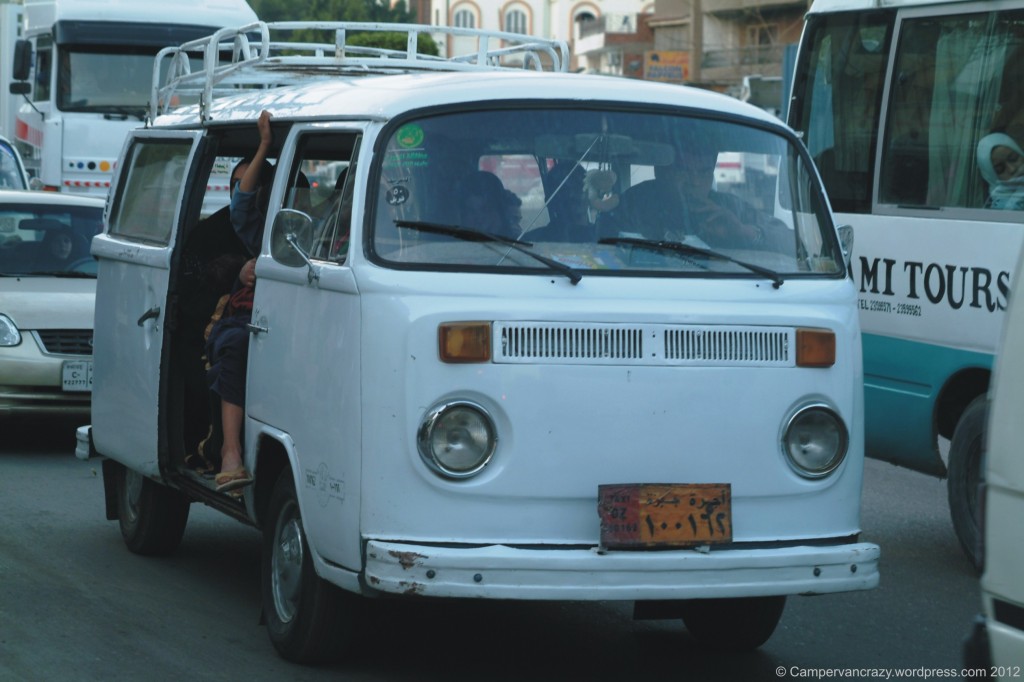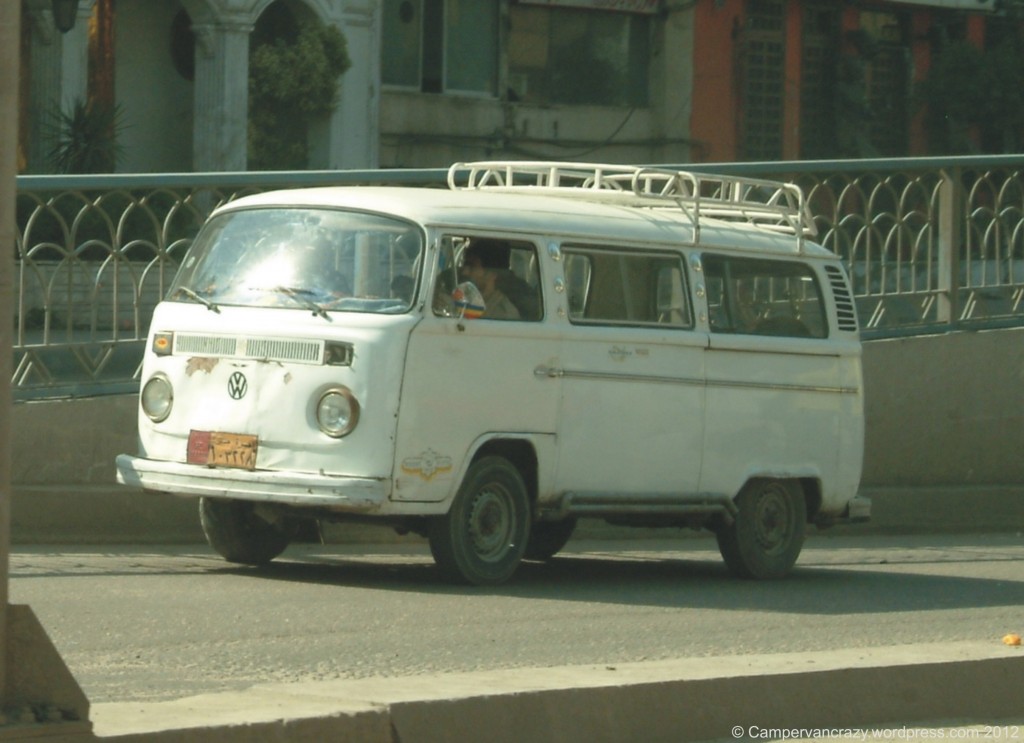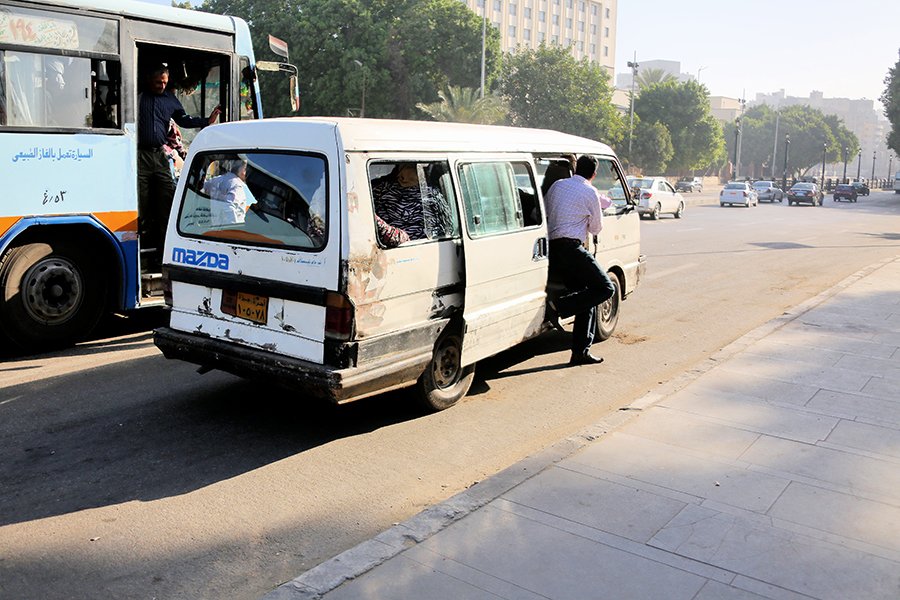
By Leia Walker, Egyptian Streets
Microbuses: beasts of the street, rulers of the road; and much like the Cairo weasel, able to slip through the smallest of gaps. With fearless drivers at the reigns, they come barreling down the street, abruptly halting just shy of the bumper in front; and they are known for occasionally roughing up other vehicles that get in their way.
Convenient, cheap and willing to drop their riders nearly anywhere along their route, microbuses are nearly always packed to the brim with Egyptians fighting the daily battle of the Cairo commute.
One thing I’ve learned in my two and a half years in Cairo is that there are two modes of transportation you don’t play “frogger” with when you’re crossing the street: motorbikes, because they swerve unpredictably and erratically, and microbuses, because they always win. It is this dedication to ruling the road that earns them the crown in Cairo’s transportation “system.”
When I first came to Egypt, a friend set me up with free housing in Heliopolis near ma7kama, as I was interning and living on a shoestring budget. The only downside to the set up was the daunting commute, which consisted mostly of taking the metro from 7elmeyet Zeitoun. The real daily battle was getting to the metro. Taxis were by far the most comfortable—and most expensive—a rare treat. The above-ground tram was the cheapest at 50 piasters, but moved only slightly faster than my East Coast walking pace and broke down frequently, so I resorted to that only when traffic was at a standstill.
The most efficient mode of transport, by far, was the microbus; and after some clueless rides and help from strangers, it became my favorite mode of transportation in Cairo. Much like the bullies they are made out to be, microbuses push and shove their way through the worst traffic, roaring at little cars, bikes and even the gigantic red buses to get out of the way. I once was in a microbus that actually pulled onto and drove on the tram tracks in order to get a few cars ahead in a midan of traffic. I used to look out the window and watch as the microbus and tram raced for first place to 7elmeyet Zeitoun. Slow and steady, sometimes the tram won; but quite frequently the rough and tough antics of the microbus drivers pulled through, and I got to excitedly enter the station prior to the tram brimming with metro riders.
Old, packed and always jerking with nearly constant and less than graceful transitions between the gas and brakes, microbuses are not the most comfortable mode of transport. The seats are often falling apart, and frequently a passenger or two stands on the side and hangs out the door. And as much as one tries to sit in an optimal position to exit without making everyone else exit first, there is always someone in the back that needs to get out before all 15 people squished in the front.
Despite this, I found microbuses delightful. There was always an endless flow coming down the street, and even if a couple full ones passed by, there was comfort in knowing the next one was only a few seconds away. Even when I was squished-in with way too many people to be remotely “legal,” I found my fellow riders to be generally pleasant in spite of the uncomfortable circumstances.
When I first started riding microbuses, I was frequently assisted by other passengers who knew that my timid “Lo sema7t, henna kwais” was never going to get the driver’s attention. I quickly discovered that one must very loudly assert an “3ala gamba, yasta,” at which point the driver will swerve over to the side of the road, the door will slide fiercely open, and you have about 5 seconds to jump out if you’re near the door before you become an inconvenience. If you’re in the back, everyone preps for a quick on-and-off, and you—as the one exiting—better have your belongings tightly packed and ready to move—as if you were about to dive out of a plane.
Did I get looks, whispers and even some comments (especially after my “masculine” leaping exit), yes; but not anymore than in other public situations or modes of transportation.
I’m perhaps the last person anyone anticipated to see on a regular Cairo microbus in 7elmeyet Zeitoun. Foreign and female with light hair and eyes, I’m doubly not expected to be on a microbus. Women do ride them, but not quite as often as men; and it’s very rare to see a foreigner inside. In fact, I was frequently and genuinely asked if I was Egyptian; because especially in that area, it is that unimaginable. Despite this, I found that the harassment was pretty minimal.
Did I get looks, whispers and even some comments (especially after my “masculine” leaping exit), yes; but not anymore than in other public situations or modes of transportation. Generally, men would make sure to give me proper space, and on nights when I had caught the last metro towards El Marg and ended up in 7elmeyet Zeitoun after 1am, I actually found microbuses to be the safest mode of transport. Men went out of their way to make sure I had a nice seat and that no one was touching me, even incidentally. There was no one-on-one scenario that makes taxis so sketchy at night, and for the most part no one talked to me.
There are limitations to microbuses. They run on specific routes, and it is essential to learn the routes in order to use the microbus system. The drivers will shout out their destination, associated with a hand signal, as they pass by waiting crowds on the street. Ideally, you will learn both of these, making catching a microbus exponentially easier for both you and the driver. For example, I lived in Heliopolis, I learned that “3rba wa nus” (4 fingers raised) and “awel abbas” (index finger raised) were the two cheapest routes I could take in order to get off at ma7kama.
Although I don’t miss the Heliopolis commute, I can say that I genuinely miss taking microbuses now that I walk to my daily activities. As someone who very rarely goes unnoticed in public, I found microbus rides to be the closest I’ve gotten to feeling like I fit in with the ebb and flow of Cairene life. I got to experience Cairo in a different way and interact with several people I otherwise wouldn’t have met. I still stood out, but I was accepted because I had learned the lingo, the etiquette and the transitions of microbus riding. There are microbus interactions and moments I will never forget; like the time a toddler started turning around to look at me and cracking up each time with no provocation other than how ridiculous he perceived me to be. This was much to the endearing embarrassment of his parents, who initially tried to “shush” him, but eventually joined me in confused laughing. I don’t feel like I experience these intimate moments as frequently on the metro, where everyone is front-to-back, psyching themselves up for the impending pushing and shoving to get out the door.
In terms of public opinion, however, microbuses and their drivers are frequently made out to be dangerous or thuggish; and “classy” people are assumed to stay clear. I will not claim that microbuses are safe or free from harassment—just like I wouldn’t make that claim for nearly any form of transport anywhere in the world. There are always risks. Microbus drivers may or may not be thugs, and the beat up buses themselves may or may not be the safest mode of transport; but the experience is not remotely what it is fear-mongered into being. You do need to learn the rules of riding them and they are a bit run down, sometimes uncomfortable and frequently come very close to running into other vehicles.
However, I enjoy riding microbuses and the experiences that come with those rides. And so if society dictates that classy people steer clear of my favorite street beasts, then please don’t ever call me classy.
Edited by Karim Hafazalla









Comments (6)
I loved riding the microbuses…. My husband hated to take me on them. When trying to experience everyday life of an Egyptian, taxi rides just dont cut it. Was not a fan of metro rail, or the buses. But for some reason, I loved the microbuses. I miss Cairo and her people.
I miss them actually lol
wait whaaat ? 😀